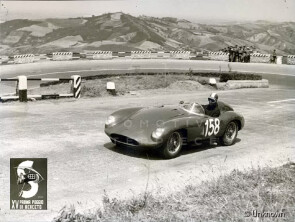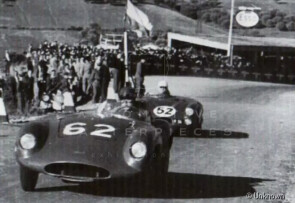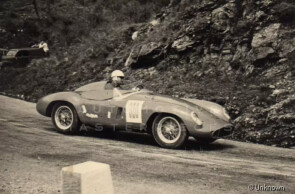
1955 Ermini 357 Sport
ON/OFF
Why am I an Automotive Masterpiece?
J. Movie cars
16th January 1957 Checkpoint (UK) Checkpoint is a 1956 British movie. The genre can be defined as a noir, a crime or a drama, it was directed by Ralph Thomas and starring Anthony Steel, Odile Versois, Stanley Baker, and James Robertson Justice. The film was shot at Pinewood Studios in London with locations in Italy, including footage of the 1956 Mille Miglia. The 1555 appears in the race with the no. 16
L. Limited edition cars
no. 3 manufactured, no. 2 remaining, 3rd built. no. 3 manufactured, no. 2 remaining, 3rd built
The fierce competition of O.S.C.A. forced Ermini to design a new car, once again. In order to stay competitive with their rivals, the Florentine cars needed a refined and new concept frame to use with the powerful "twin-spark" headed engine. The development of this engine was prolonged due to the difficulty of finding an adequate distribution; problem solved by Magneti Marelli with the creation of a specific distributor. This is why, in early 1953, Ermini officially commissioned Alberto Massimino to design a brand-new chassis, thus abandoning the Fiat parts used up to that time. The tubular frame was built by the Caiani company in Modena, while the new mechanical parts were built in-house according to Massimino's blueprints; it had an independent wheel front suspension system, formed by two overlapping triangles with a helical spring and hydraulic telescopic-coaxial shock absorbers. The rear live axle (with an aluminum differential housing) had "cantilevered” leaf springs, an ingenious thrust arm and torsion bar system. Since 1952 the cars of the Florentine constructor had been registered by the General Department of Motor Vehicles of Florence as Ermini, since the engine was entirely produced in-house. Only In 1955, and thanks to the new project, “AMFIAA" (National Automobile Industry) acknowledged Ermini as a car manufacturer, thereby allowing the factory to begin its own car registration numbering system. The first chassis of the "357" project, equipped with the new twin-spark engine (already planned by Ermini in winter 1951), was presented in March 1954 at the Salone dell’Automobile in Torino. “357” originally stood for the unit displacement of the 1430cc engine but was later used to identify all the cars built on the new chassis with twin-spark engine. The car was completed only in the month of June, bodied by Frua as a barchetta, but the aerodynamic setup of the Turin’s coachbuilder did not convince Ermini. As for the setup of the other remaining chassis, Ermini exploited Massimino's ideas and commissioned Scaglietti to design a sinuous and elegant aluminum body but only three of the five Ermini 357 chassis were bodied by Scaglietti, since Enzo Ferrari, who had an exclusive agreement with the coachbuilder from Modena, was not able to tolerate the competition of the small Florentine factory in "his" own town. For this reason, the other two remaining chassis were bodied by the Fratelli Morelli in Ferrara, shaping the same Scaglietti's line. As for the 1955 season, the new Ermini 357 were the best any technology of that time could achieve, good for fighting on equal terms with more experienced car builders. The 357 Scaglietti made its debut winning the 1100 cc class at the Circuito delle Torricelle. That same year, the Sport class “up to 1500” revived, inducing Ermini to set up a 1500 cc engine for a class that promised to be interesting and hard-fought. Since the basis was the aluminum 1100cc block which, because of its size, could not be bored more than 75 mm, Ermini had to increase the stroke to 81 mm for a total displacement of 1431 cc. Despite the excellent performances of the new engine, the car builder had to cope with his inexperience in the 1500 class, whereas the 1100 racing season was thrilling, to say the least. In any case, only a 1500 cc engine was built, since it was not as balanced as the 1100 unit, "oversquared" (higher rpm and more acceleration) and therefore more reliable. Another twin-spark 1390 cc engine was installed on a 357 chassis, but it was never bodied. As Ermini's health sadly got worse, the spirit necessary for the development of the model "357" faded.
Chassis 1555 was an Officine Ermini Firenze works car and the only Ermini 357 1500 Sport. It ran several races from 1955 to 1962 with 1431cc and 1100cc engines. This car took part with Libero Bindi in the Mille Miglia, Gran Premio Supercortemaggiore, Circuito del Mugello and Parma-Poggio di Berceto; with Giovanni Buoncristiani in Targa Florio, Coppa della Consuma and Bologna San-Luca; with Roberto Dolfi in Coppa della Consuma and Vinci-San Baronto. At the end of 1955, Enrico Manzini's Ermini 357 Scaglietti was equipped with the 1500cc engine originally mounted on the chassis 1555 and was sold to an Italian-American, Tony Pompeo, who exported the car to the west coast of the United States.







